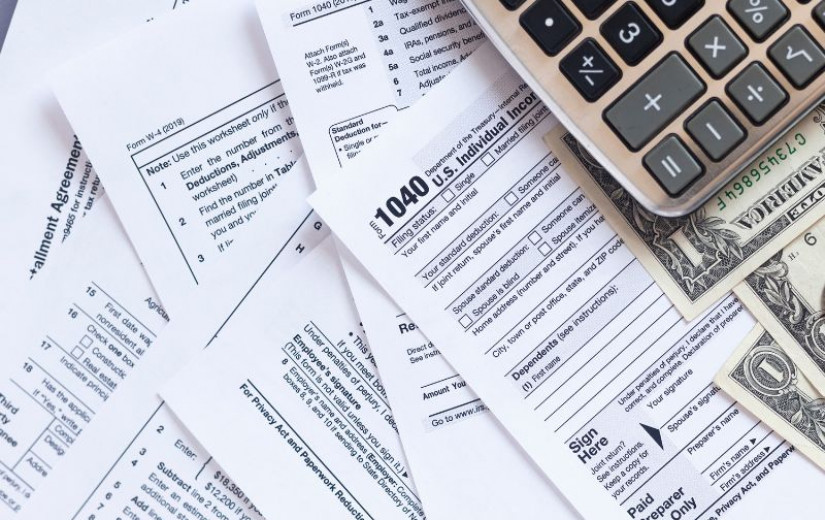
On any given weekday, the line at the Weld Food Bank will stretch well out of the parking lot onto H Street. On the busiest days, the line may even back up to the FedEx shipping center, nearly a half mile north of the food bank.
A line of that magnitude was unfathomable to food bank staff and volunteers before the COVID-19 pandemic. Even a few years ago, it was quite the surprise when the line left the parking lot.
“The line to the street used to be a couple times a year, and when that happened, it was panic,” Director of Marketing and Communications Weston Edmunds said. “Now it’s every time I drive in.”
This year, through the Emergency Food Program and the Senior Feeding Program — the two programs that operate out of the warehouse at 1108 H St. in Greeley — the food bank is serving an average of 1,700 people daily, five times the daily pre-pandemic average of about 300 people.
The 152,000 emergency food packages the food bank distributed last year was up 48% from 2023, and up 430% from 2019.
“The biggest misconception is that people are coming to a food bank, then guess what, they’re at poverty level. That’s not true,” CEO Bob O’Connor said. “If you’re at poverty level, you’re getting SNAP, you’re getting some kind of federal dollars. It’s those people that are right above that level, what do they get to see? Nothing. And those are the people we’re seeing now.”
That increased demand has left the food bank facing a $700,000 budget shortfall, spurring the organization to launch its end-of-year “Bridge the Gap” campaign.
The Weld Food Bank has long been the organization that steps in when the community needs a little help to get through a tough time. Now, the organization is the one asking the community to see it through an unprecedented time.
“The need is overwhelming. And for the first time, I think we feel somewhat unsure of whether or not we’re going to be able to reliably provide the services we have for the last 40 some odd years,” Chief Development Officer Stephanie Gausch said. “The need continues to grow, and our resources are just not growing at the same pace.”
Food banks have long worked under the model of taking excess food — whether from farmers, grocery stores or families — and distributing it to where it is most needed.
“For the bulk of our existence, we’ve been able to exist working in this model,” Gausch said. “Where we are taking food that was destined for the trash and giving it to people in need. But the shifts in supply chain and inflation, and just everything that has transpired to change our world during COVID, has changed food banking. And there’s not that excess in the system the way that there used to be.”
It will cost the Weld Food Bank about $7 million to operate in 2025. Of that, $5.5 million comes from donations and other ways of fundraising.
In the past, most of those donations have come in smaller increments from everyday people: $50 here, $100 there. The rest of the donations are bigger, but fewer and further between, and typically from business partners.
Lately, the organization has noticed a shift in the way the money is coming in.
“We’ve seen a decline — really, a halting — in donations at the $100 level and lower,” Gausch said. “What that says to me is that people like you and me, who love being able to support a great organization in their community and are used to writing that $100 check, they don’t have that bandwidth in their budget any more.”
But conversely, those larger donations have actually increased. Not necessarily in frequency, but in amount.
“We’ve been able to keep the boat afloat with these larger donations,” Gausch said. “But it’s very nerve wracking to look at, because you don’t know at what point that breaks. The folks who have previously given $1,000 who now give $1,500, what if they’re not able to give $1,700. This can’t keep going forever, but the line keeps growing.”

The Weld Food Bank doesn’t receive any funding from Weld County, or any municipalities within it, Gausch said.
Historically, that remaining $1.5 million has been supplemented by federal funding. But recently, several federal funding sources have been cut.
Cuts to the Local Food Purchase Assistance Program — a USDA program — have left the food bank with $150,000 worth of fresh food to find elsewhere. Cuts to the Emergency Food Assistance Program, also through the USDA, have left the organization even more handcuffed.
“The hard part about that is a lot of the USDA food that we get is protein,” Gausch said. “It might be meat, it might be dairy. But it’s more expensive products.”
One of the more surprising funding challenges has come as an unintended consequence of universal free lunches being implemented in Colorado schools for the 2023-24 school year.
Low-income families not being required to sign up to receive free lunches has reduced the stigma around children eating free at school. But because families don’t have the onus to sign up to receive free meals, it has also reduced the amount of people who sign up — skewing numbers, Gausch said, of how many people are struggling with food insecurity.
“Our free and reduced numbers are getting lower and lower, but hunger is growing and growing,” Gausch said.
Several programs the food bank runs rely on those numbers to be federally reimbursed for the food they are distributing.
“We are eligible for federal reimbursements, but only if we serve those meals in areas that are designated as high need,” Gausch said. “Fewer people fill out that paperwork, those areas of high need are shrinking and shrinking.”
To be designated as high need, an area must have more than 50% of families in the area qualify — and signed up for — free or reduced lunches.
Gausch used a time the food bank served meals to children at the Galeton Boys & Girls Club as an example. The side of the street the club was on was in an area that was not deemed high risk, so the food bank had to serve meals across the street, an area that did qualify for reimbursement.
“The children had to physically move across the street to be fed the meals,” Gausch said. “All of those eligible areas on that map are driven by data from free and reduced lunch. So when people don’t fill out the forms, we don’t get the information. So that looks artificially lower than it is.”
The most prominent cuts to federal funding, however, has come as part of the “Big Beautiful Bill” that President Donald Trump signed into law in July. Some changes that went into effect upon the bill being signed include:
- Requiring able-bodied adults to work 20 hours per week to be eligible for SNAP benefits.
- Restrictions to the USDA Thrifty Food Plan, a USDA program that outlines nutrient-dense foods and beverages and associated costs that can be purchased on a limited budget. The program is updated regularly due to inflation, but the bill requires the plan not be reevaluated before October 2027, and that future reevaluations are held cost-neutral.
- Restrictions to SNAP for certain legal immigrants, including forcing many to be in the country for five years to qualify for benefits.
- Prohibiting internet costs from being counted as an allowable shelter expense for SNAP’s excess shelter deduction.
At the beginning of October, all funding to SNAP education was eliminated.
“We used to be able to operate a ‘Cooking Matters’ class, which was a six-week class where a nutritionist would come in and teach folks how to cook healthy on a budget,” Gausch said. “They’d go to the grocery store and practice shopping for healthy food on a budget.”
Next October, Colorado will begin footing 75% of SNAP administrative costs, up from the current 50% the state is burdened with now. Colorado counties are expected to have to pay $73 million under the new policy, up from $49 million in 2024.
In October 2027, states will be required to pay a share of SNAP benefits for the first time in the program’s history, tied to a state’s payment error rate. Payment error rates measure the accuracy of each state’s eligibility and benefit determinations, according to the USDA.
States with error rates between 6% and 8% will pay 5% of benefits, states between 8% and 10% will pay 10% and states with error rates over 10% will be on the hook for 15% of benefits. States below 6% will see no benefit-cost share.
Currently, Colorado has an error rate between 8% and 10%, according to Feeding Colorado.
Feeding America is a nonprofit that has built a nationwide network of more than 200 food banks that fights hunger in America. Feeding Colorado is the partner state association of the five Feeding America Food banks that serve Colorado and Wyoming.
In Colorado, 298,000 families will lose some or all of their SNAP benefits once all the changes have gone into effect, according to the Urban Institute. Of those, the Urban Institute estimates 36,000 families could lose benefits altogether.
Currently, there are 615,000 Coloradans on SNAP benefits — 50% of those are children. For every meal Feeding Colorado serves, SNAP is responsible for nine, according to Government Relations Manager Ron Meehan.
Nationwide, the numbers are even more staggering, Meehan said.
“Feeding America is estimating that it will take 6 billion meals a year off the tables of people we serve. And half of those are kids,” Meehan said. “And keep in mind, our whole network only served 5 billion meals last year. We’re talking about 120%. We’ve weathered unprecedented storms before, but we simply don’t have the capacity to make up the difference.”
And the food bank isn’t only focused on cuts to SNAP. It is also worried about people losing Medicaid coverage.
Over the next 10 years, federal spending on Medicaid in Colorado alone is estimated to decrease by $14 billion, according to KFF research.
“We’re concerned not just about SNAP, but we’re equally concerned about Medicaid,” Edmunds said. “Because if somebody gets their insurance cut, they’re skipping the doctor, or they’re going to the doctor and the bill is bigger, and that’s food off their table.”
What’s next?
If the Weld Food Bank doesn’t reach its $700,000 goal, it won’t cease to exist at the end of 2025. The bank has been putting money aside for years and has some reserve funds. It’s next year, and the year after that, that worries the organization.
“Next year forecasts even bleaker,” Gausch said. “If we go to the well for this huge chunk now, then there’s none for next year.”

So the food bank is asking for just a little bit more from its donors who have supported the organization for so long.
“There is something you can do,” Edmunds said. “If you can’t do $100, please know that $25 makes a huge difference. But also, just donating two hours of your time.”
Volunteers are what keep the Weld Food Bank running, Gausch and Edmunds said. In 2024, volunteers spent 71,000 at the food bank. That equates to more than 34 full-time staff members working 40-hour weeks — more than the 32 full-time staff members the food bank employs.
“We are beyond committed to this community, and this community is beyond committed to us,” Gausch said. “So at no point does it look like Weld Food Bank shuts down. But what it might look like is we limit the amount of food we can give out, we limit the amount of times you can come or our programs and the reach they have shrink.”
And the “Bridge The Gap” campaign isn’t a long-term solution. Just the name itself indicates the program is putting a Band-Aid on a much more serious issue.
That is, in part, why the food bank on Wednesday hosted Colorado Attorney General Phil Weiser to tour the warehouse and learn about some of the issues facing the Weld Food Bank and many others across the state.
“People ask us a lot. They ask us, ‘How do we solve this?’ ” Edmunds said. “There are forces at play higher than us. But our job here is to address the need in the present moment in our community. We will advocate for things, but this is out of our control.”









